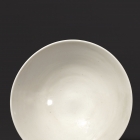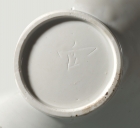J.J. Lally & Co., Oriental Art / New York City, New York
MenuPast Exhibition
EARLY CHINESE WHITE WARES
The Ronald W. Longsdorf Collection
September 11 - October 3, 2015
23.
A THINLY POTTED CONICAL BOWL
Late Tang Dynasty-Five Dynasties, A.D. 10th Century
Xing or Ding kilns
with flat flaring sides rising from the concave rounded center to a well-finished lipless rim, standing on a knife-pared ring foot with shallow straight sides and chamfered outer edge, covered inside and out with a clear glossy glaze, showing a few ‘tear marks’ on the underside, the slightly recessed flat base also glazed, the well-trimmed edge of the foot unglazed exposing the fine white porcelain, incised through the glaze on the base before firing with the character 官 ‘guan’ (official).
Diameter 6 1⁄8 inches (15.6 cm)
A similar conical bowl of slightly larger size, with incised ‘guan’ mark on the base discovered in 1985 in a hoard of thirty-two ‘guan’-marked porcelains and other ceramics excavated at Huoshaobi village in the northern suburbs of Xi’an and now in the Xi’an Institute of Cultural Relics Preservation is illustrated by Zhang (ed.), Zhongguo chutu ciqi quanji (Complete Collection of Ceramic Art Unearthed in China), Vol. 15: Shaanxi, Beijing, 2008, p. 92, no. 92, described as Tang-Five Dynasties and attributed to the Ding kilns at Quyang, Hebei province. The same bowl was previously illustrated in Zhongguo taoci quanji (The Complete Works of Chinese Ceramics), Vol. 5: Sui, Tang, Shanghai, 2000, no. 158.
Compare also the ‘guan’-marked conical white porcelain bowl of larger size in the collection of the Hunan Provincial Museum illustrated in Dingci yaji: Gugong bowuyuan zhencang ji chutu Dingyao ciqi huicui (Selection of Ding Ware: the Palace Museum’s Collection and Archaeological Excavation), Beijing, 2012, pp.140-141, no. 54.
White porcelains bearing the incised mark ‘guan’ have been excavated at the Xing and Ding kiln sites in Hebei province and in many different regions in China, from dated tombs, pagoda foundations and hoards. The earliest documented discovery of ‘guan’-marked white porcelains to date was at Lin’an, Zhejiang province in the tomb of a high official named Qian Kuan (d. A.D. 895), the father of Qian Lu, the first king of the State of Wu, and the tomb of his wife, Madam Shuiqiu (d. A.D. 901), where many white porcelain dishes, bowls and cups with incised marks of 官 ‘guan’ (official), and 新官 ‘xin guan’ (new official) were found. Some scholars have suggested that porcelains incised with ‘guan’ and related marks must have been a special category of ware made for the use of high officials or as special tribute wares, but other scholars suggest the appearance of these ‘guan’-marked wares at widespread sites including overseas trade ports indicates that these high quality white wares were not produced exclusively for use of the court.
晚唐-五代 邢窰或定窰「官」字款白瓷斗笠形碗 徑 15.6 厘米

